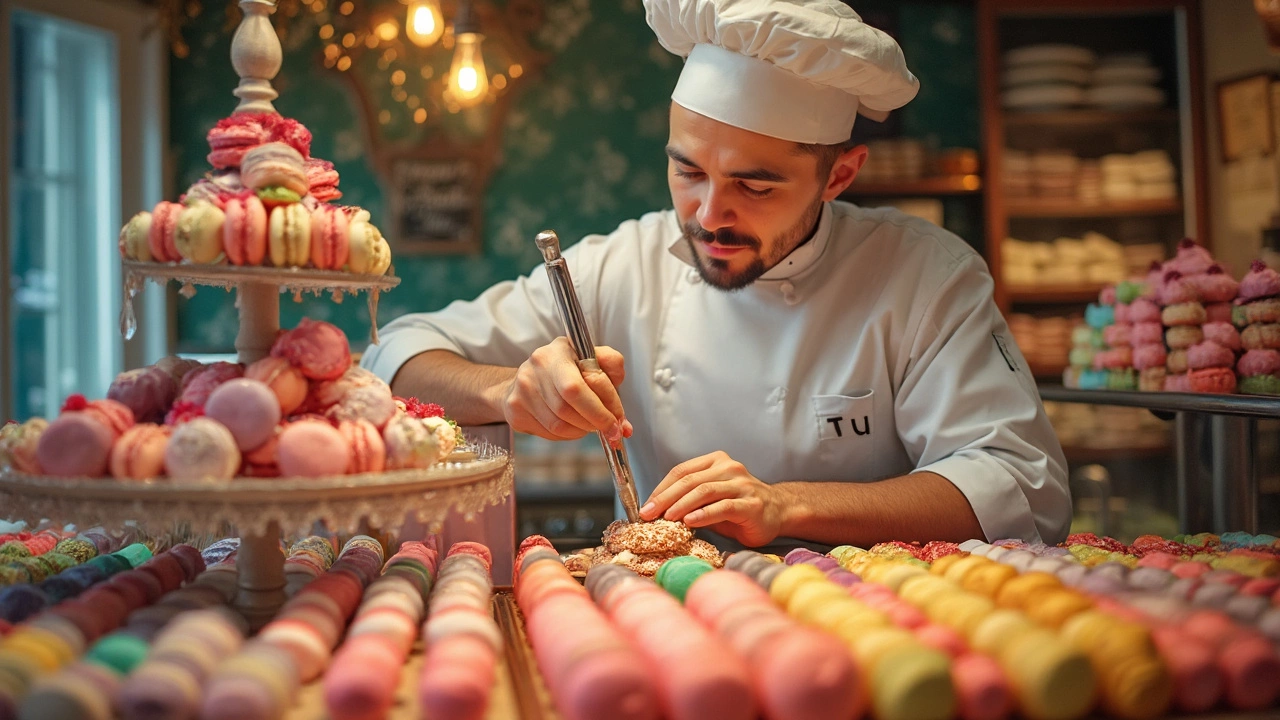
Macarons are these dainty little things that are both a treat for the eyes and the taste buds. But these seemingly simple desserts are known for being tricky to make. It's all about that balance—getting that thin shell with the chewy inside just right.
And don't get them confused with macaroons; those are entirely different things. Made with ground almonds, egg whites, and sugar, macarons can be a real challenge, even for seasoned bakers. Maybe it's their delicate nature that makes them so loved—and feared—by so many!
- History of Macarons
- The Art of Making Macarons
- Common Mistakes and How to Avoid Them
- Baking Tips for Perfect Macarons
History of Macarons
The beloved macarons have a history that's as colorful as their delightful shells. These treats are often associated with France, but their origin story begins in Italy. Legend has it that macarons were brought to France by Catherine de Medici when she married King Henry II in the mid-16th century. Back then, they were simple almond cookies, without the luscious filling we're familiar with today.
During the French Revolution, two Carmelite nuns, seeking asylum in Nancy, France, made and sold macarons to support themselves. This act of survival is part of what helped these pastries gain popularity. They became known as the "Macaron Sisters," and their recipe spread, establishing the macaron's place in French confectionery.
"There's something absolutely magical about combining simple ingredients like almond flour, sugar, and egg whites to create a macaron's delicate texture and taste." - Pierre Hermé
It wasn't until the 20th century that Pierre Desfontaines, the grandson of Louis Ernest Ladurée—the founder of the renowned Parisian pâtisserie Ladurée—decided to sandwich two macaron shells together with a ganache filling. This innovation gave us the flavorful, colorful treats that are familiar today.
Nowadays, French macarons are celebrated worldwide, with flavors ranging from classic vanilla and chocolate to adventurous combinations like matcha and yuzu. Whether enjoyed in a Paris café or made at home, they hold a special place in the heart of dessert lovers everywhere.
The Art of Making Macarons
Crafting macarons isn't just about throwing ingredients together and hoping for the best. It’s part science, part art, and all about technique. If you've ever tried your hand at making these iconic French pastries, you'll know that precision is key.
Getting the Ingredients Right
The core ingredients are almond flour, egg whites, confectioners’ sugar, and granulated sugar. Think about this like a scientific formula; proportions matter a lot. Fresh, room-temperature egg whites are often recommended since they whip up smoother and fluff better.
The Importance of Macaronage
Macaronage is the meticulously skilled mixing method that seems to cause so much trouble. Mix too little, and your batter's lumpy and rough. Mix too much, and it ends up runny. Aim for a consistency that flows like lava when you drop it from a spatula into the bowl—it should settle back into itself in about 10 seconds.
Piping Like a Pro
After nailing the macaronage, piping the mixture with precision is next. Use a round tip and pipe small, consistent circles on a lined baking sheet. Tap the baking sheet on the counter a couple of times to remove any air bubbles.
The Crucial Resting Step
Letting your piped macarons sit before baking is critical. This step lets them form a skin, preventing cracks. You know they're ready when the tops are dry to the touch.
Baking to Perfection
Bake at the right temperature—typically around 300°F - 325°F (150°C to 160°C)—for about 12 to 15 minutes. Little 'feet' should appear on the bottom, and cracks? Big no-no!
Once you've mastered these steps, you’re well on your way to creating perfectly delightful macarons. Sure, it might take a few attempts, but that's just part of their charm, right?

Common Mistakes and How to Avoid Them
When it comes to making macarons, there are a few tripwires that even the best bakers can fall into. Let's dig into these pitfalls and figure out how to sidestep them for that perfect French pastry.
1. Incorrect Ingredient Measurements
Precision is key when it comes to baking macarons. Too much or too little of an ingredient could spell disaster. Always use a kitchen scale to measure your ingredients. This isn’t your typical 'eyeball it' baking; each gram counts!
2. Under or Over-mixing the Batter
The folding technique, called macaronage, ensures your batter has the right consistency. Your batter should flow like lava and fall in ribbons from your spatula. Under-mixing leaves you with lumpy tops, while over-mixing results in flat, spread-out cookies. Practice getting a sense of the texture to avoid these mishaps.
3. Skipping the Resting Period
Your macaron shells need some downtime once piped. Skipping this step could make those little feet—the hallmark of a perfect macaron—not appear. Let the shells rest for 20-40 minutes until a skin forms. It might seem like a wait, but it's crucial for success.
4. Not Using the Right Oven Temperature
Every oven is different. Macarons are sensitive to temperature shifts, so having an oven thermometer is a lifesaver. If they're browning too fast, your oven could be too hot. Too low, and they might not rise properly. Stick within the 140-160°C (284-320°F) range, but adjust based on your oven's quirkiness.
- Tip: Baking a small test batch can help tweak the temperature.
If you keep hitting a baking wall, you're definitely not alone. Even French pastry chefs have their misses. With these fixes, you have a good defense against common macaron missteps. See, making desserts like a pro is within reach!
Baking Tips for Perfect Macarons
Getting the perfect macarons can be a bit of a journey, but with the right tips, you'll be on your way to baking success. Here's what you need to know to make your batch a dazzling success.
Preparation is Key
Before you begin, make sure you've got all your ingredients ready and measured. Baking macarons isn’t about improvising—precision is everything.
- Use room temperature egg whites. This helps them whip more easily and achieve that nice glossy peak.
- Sift your almond flour and powdered sugar. It might seem tedious, but it helps get that smooth shell.
- Invest in a kitchen scale. Weighing your ingredients is much more accurate than using cups.
Nail That Meringue
The meringue is the heart of the macaron. Beat your egg whites until they're stiff but not dry. Here's a quick tip: use a metal or glass bowl and make sure it’s spotless—any grease could ruin your meringue.
Learn the Art of Macaronage
This is the fancy term for folding your dry ingredients into the meringue. It takes practice to get this step right. You want a flowing batter that doesn’t hold peaks. A useful test is to scoop a bit and let it fall back in on itself—it should spread slowly, like lava.
Piping with Precision
Using a piping bag, pipe small, consistent circles onto parchment paper. If you're new to this, using macaron templates can help you keep sizes even.
Rest and Bake
Once piped, let them rest. Depending on the humidity, this could take anywhere from 20 minutes to an hour. You’re looking for a skin to form on top that you can lightly touch.
Bake in a preheated oven, typically around 300°F (150°C). A handy detail to check: after a few minutes, you should see those iconic feet start to form.
Baking macarons does take patience and practice, but once you get it down, you'll find it really rewarding. Keep these tips in mind, and soon enough, you'll be sharing your colorful, perfected creations with the world!